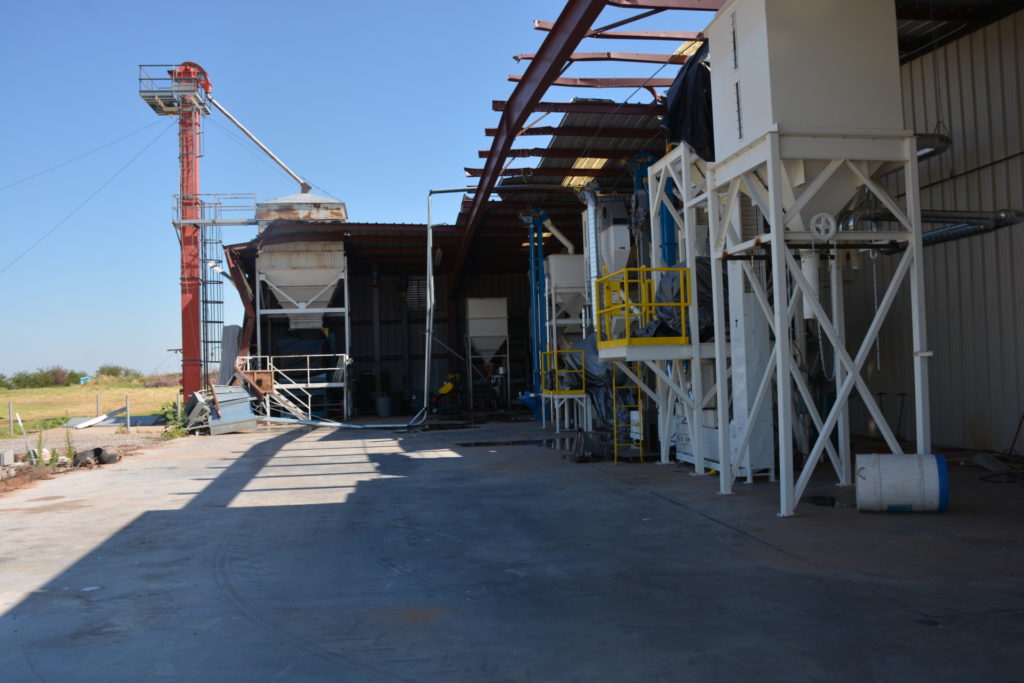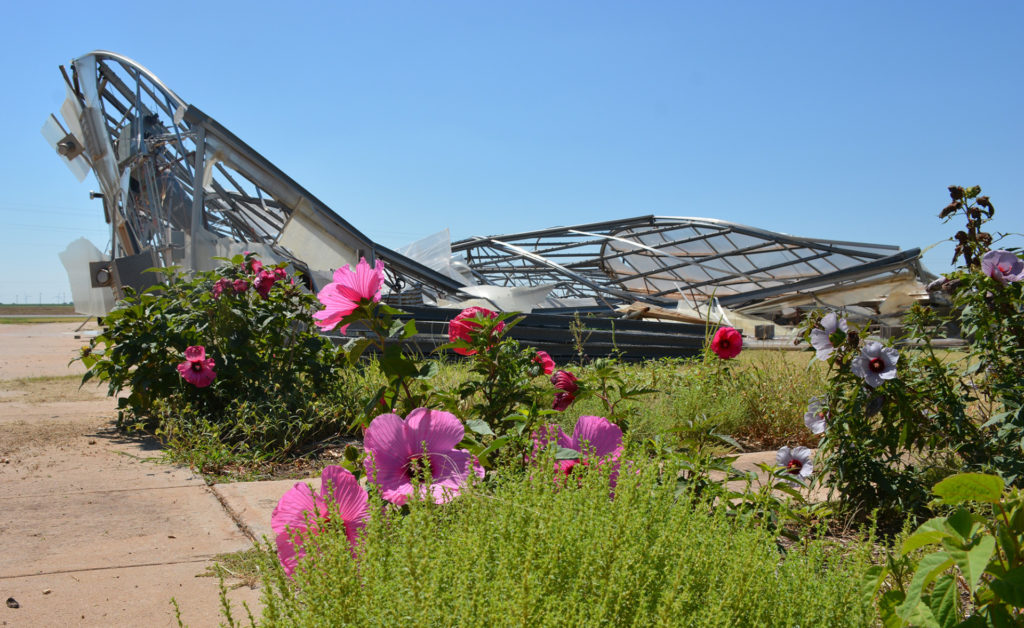Repairing tornado damage takes time, but research, outreach continue
Texas A&M AgriLife ensures facilities at Vernon are operational, serving stakeholders
Advancing the newest peanut varieties may take an extra year and this year’s peanut crop may not run through the new peanut sheller. But the Texas A&M AgriLife Research and Extension Center and Texas A&M AgriLife Foundation Seed at Vernon continue to serve their clients after a May 4 tornado.

For Rick Vierling, Ph.D., center director, it’s not so much the existing damage that keeps him busy but rather the greater damage that could occur if large pieces of equipment and laboratory research are not secured quickly.
With greenhouses flattened, roofs missing and storage destroyed, Vierling said the most significant concern is “not how much damage has been done, but how much damage could be done to the center’s research and Foundation Seed’s production, and the impact to the seed industry and farmers, if we don’t get everything secured and replaced.”
Texas A&M Foundation Seed impacts
Currently, the wheat seed cleaning plant is missing a roof, but the wheat harvest is almost complete. Seed companies will be needing Foundation Seed products in September as producers begin looking to plant next year’s crop.

Also housed in that warehouse and in the portion of the building where the roof was stripped away is the new $1.3 million-plus peanut sheller that might have to sit idle this year. While the two pieces of equipment will be placed in a temporary enclosure shortly, Vierling said everything on the peanut sheller must be cleaned and the wiring checked once electricity is available.
“We don’t believe the new peanut sheller was damaged, but a lot of the supporting equipment and infrastructure was destroyed,” he said. “The good news is that Texas peanut shellers have stepped up to help Foundation Seed with peanut shelling. The damage will impact seed stocks of new Texas A&M AgriLife peanut varieties more than it will the established varieties.”
And some seed expansion, such as that of a new nematode-resistant peanut variety, NemaTAMII, will have to wait a year. The variety was supposed to be planted the week of the tornado, but Foundation Seed personnel could not get it seeded after all the damage. The same is true with a hybrid millet that is highly sought by the dairy industry to make silage.

Four millet fields were planted and will be harvested this fall, so Vierling said the team will be able to move a smaller seed cleaner into the warehouse to process that seed.
“Basically, we need to build a temporary structure around this infrastructure,” he said. “We hope to have that in place within weeks.”
And with wheat coming out of the fields, Vierling said Foundation Seed also must replace destroyed storage bins. The small grains and peanut programs will get 12 new smooth-wall upright bins with 45-degree bottoms.
“With some of our newer plant varieties, we can’t do the seed increases that were needed to be able to sell the seed this year, but we will be back up to capacity by next year,” he said.
Texas A&M AgriLife center concerns
With a dedicated staff of Texas A&M AgriLife Research scientists and support personnel going the extra mile to secure and continue research projects, Vierling said the field research was impacted very little by the tornado and is proceeding as planned.

“But our lab research was impacted,” he said. “Equipment is being moved from damaged to non-damaged buildings, and we are looking at ways to get everything online.”
Vierling said the center’s headquarters building will need a major remodel after the front was damaged and the roof was stripped off. Additionally, garage doors, equipment storage areas and greenhouses will have to be replaced, not to mention a number of vehicles that were severely damaged in the storm.
Lorrie Coop, Texas A&M AgriLife Extension Service district administrator, said the situation has been extremely hard on staff displaced due to the tornado, “but we have done what we could to maintain operations while working from home.
“At first, we compared it to the beginning of 2020 when everyone was working from home due to COVID-19, but we have come to realize that it is not the same. Our Extension offices in Knox and Wilbarger counties have allowed Dr. Vierling and me to use their facilities for our day-to-day operations, and it has been extremely helpful for us to have a ‘base’ of sorts as we manage this situation and try to coordinate efforts.”
However, Coop said, with the new projected completion date for center repairs being sometime in the fall of 2023, they are now looking for a temporary alternative office space that can house AgriLife Extension staff and better meet their needs.
“We know going into the fall, we will need to have space to work and coordinate the many activities that our agents will be conducting across our 24 counties,” she said. “You don’t realize how important little things like being able to make copies or print documents are until you can’t do it anymore without a great deal of planning and preparation.”

Coop said AgriLife Extension is also looking at what agricultural equipment will need to be repaired and/or replaced so specialists can continue conducting applied research and supporting agents in their fieldwork.
Fortunately, the tornado spared all the planting equipment, according to Emi Kimura, Ph.D., AgriLife Extension agronomist and state peanut specialist.
“We were able to plant all RACE (replicated agronomic cotton evaluation) trials and other cotton variety trials, small plots trials and peanut trials for the season by collaborating with farmer cooperators,” Kimura said. “We appreciate their help and support to keep our agronomy program going in this difficult time.”
In contrast, she said, some harvesting equipment for cotton and peanuts was severely damaged and needs to be replaced. The team is searching for those replacements.
Kimura said she has received lots of encouraging and supportive emails and phone calls from colleagues within and outside Texas A&M AgriLife, including from industry, farmers and commodity groups and is thankful for all the thoughtful messages. She also said she has no plans to slow down her program and plans “to keep providing important and timely data to our producers and ag industry colleagues.”
New opportunities for improvement
Coop said the tornado definitely made things harder but also presented a unique opportunity.
“This allows us to look at what is needed to update the center to be more cost-efficient while also designing a space that can better meet the needs of our employees as well as the citizens of the Rolling Plains who depend on us,” she said.
“For example, we are looking to expand our meeting space so we can host trainings for agents that will help enhance their skills and give them resources to take back into their counties,” Coop said. “We would also like to add a demonstration kitchen so agents can develop and conduct educational programs in nutrition, health and wellness while also reaching a much broader audience through video technology.”
She said the current center design does not have a functional space that agents could use for education and strongly believes this much-needed addition will greatly improve agents’ ability to ultimately reach new audiences.
“The center celebrates its 50th birthday this year and, as you can imagine, it was already in need of repairs before the tornado,” Coop said. “As we move forward, we are being strategic in how we manage the rebuilding to create a facility that is not only functional, but also one we can be proud of and one that can better serve the citizens of the Rolling Plains for the next 50 years.”


